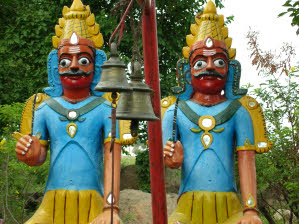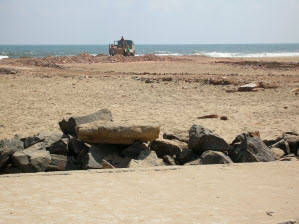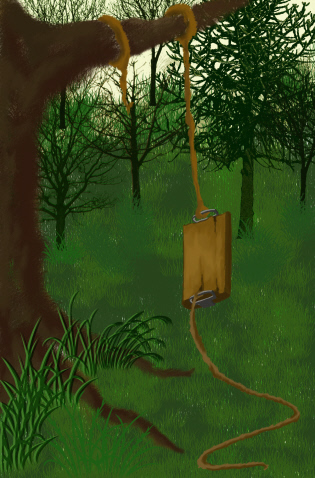by Anupama Krishnakumar
[box]In December 2004, as a student of journalism, Anupama Krishnakumar embarked on a week-long visit to a village she had never ever heard about in her life till then. Only later did she realize that it was a trip that would set her thinking. It was soon followed by another revealing experience – the Tsunami. Reporting on the Tsunami threw the doors open to a different kind of experience – one that gave way to a very crucial question – what was it like to face a disaster? Presented here, the diary entries of an awe-struck journalism student.[/box]December 15, 2004: AARKAVAADI.. It was one of those many, many villages that the Mahatma called the backbone of the country. As a student of journalism, I had to undertake a week-long field-trip to a village to understand the many aspects of deprivation and how one, as a journalist, would cover them in order to drive a change for the betterment of the deprived people. Aarkavaadi is roughly a two-hour drive from the temple town of Tiruvannamalai in Tamilnadu. Our team of students and two professors stayed in a hotel in Tiruvannamalai and used to leave for the village every morning at about 8, in a van, and return by around 7 in the evening. I was a novice as far as my understanding of villages went, I simply couldn’t imagine how they worked and all that I knew of villages were the cinematic representations flashed across the silver screen with its high levels of dramatization. With the dreadful thought of travelling through those rustic, so called roads for four hours every day on the one hand and the burning curiosity to explore a world totally unknown to me, on the other, I set out on the trip.
The van would race along the dusty path, with green fields stretched out on either side. Watching the green world out, from inside the van, was a philosophical experience. Whoever said that the other side of the shore is green, sure said the right thing. I saw the appalling truth that, what people inside the van held, as fascinating experience, was dull routine for those outside. And for all those, who just looked up from the fields and peered at the white van that raced through their roads once in a blue moon, it was a representation of a luxury, they were yet to claim in their lives.
When I entered Aarkavaadi for the first time, the first thing I felt was a sense of shame. I read the municipality board and realized that all month long, ever since the deprivation tour list came up, I had been managing to pronounce the name of the village all wrong! What could I call it- an arrogance or an attitude that wouldn’t care much for a name because it was after all a small village tucked to a corner? The kids peered at us from behind the school gates, the women watched us in silence from inside their houses and the old woke up from their nap to see a whole set of aliens. A strong sense of unfamiliarity, a hesitation to come forward and speak, I surely felt like an intruder into their private haven. A day or two, however, one quickly felt that strange sense of attachment that they held for people like us, strangers. At one point, covering deprivation became a sincere task of listening, to woes that went unheard, to triumphant personal stories that saw no recognition, to tales that were so moving. Their lives taught me lessons in their own ways. “Why are you asking us questions? What will you do for the village?”, 60-year-old Kanimma asked me quite puzzled. “We want a government bus through Aarkavaadi. We want a government hospital here. We want a bridge to be built over Muskundan river. Can you do something about it?” She hit the bull’s eye. While I was pondering over an answer, Andaal, a 60- year-old lady said, “They have come here to study and take reports. If you ask her what she will do, what can she do?” throwing a glance at me for confirmation. Was her understanding so worldly or was the answer that simple? She set me thinking.
35-year-old Saradha couldn’t hold her surprise when she saw her picture on my digital camera. She exclaimed that she had seen photographs of her daughter’s wedding but, not this fast! It was an insight into their innocence and also their effort to be on par with the “city people” – “We know cameras too!” Manikandan’s mother couldn’t digest the fact that a cinema ticket in the city cost Rs 80 and Saradha complained that she did not receive her Rs 25 ‘Government Salary’, regularly every month. The inequality stared at my face. 29-year-old Abiraami’s boldness stunned me. She definitely altered my mind’s picture of a ‘village woman’. Bold and daring, she described how she delivered a dead baby at the end of eight months, because the entire village was flooded and they couldn’t reach the hospital on time. She just laughed it away and I realized she was just one of those millions, who suffered from a lack of choice and had accepted it as a way of life.
A week in a place, where the Internet seemed a distant dream and mobile phones were mere dummies with no signal available, meant discovering certain truths. Covering deprivation was switching into a mode of experiencing the lack of what one took for granted. It was a revelation to cruel poverty. It wiped out misconceptions and preconceived notions, showed the glaring inequity and demonstrated the villagers’ craving to ‘develop’ and secure a representation for themselves. As for me, it was – realization.
26 December 2004. It is a day that would be etched in the minds of so many people – for different reasons, perhaps. It was a day when the world realized the consequences of nature’s fury. In my case, it took a certain act of ‘chasing stories’ to realize the extent of destruction that the Tsunami had caused; it is not just the physical loss, the emotional damage it led to was unimaginable. After meeting officials, relief workers, doctors and victims, in the process of reporting on the Tsunami, the question that haunted me was – what does it actually mean to experience a disaster? There were lives that were just washed out 4 Km from where I sat – Spencers Plaza on Mount Road in Chennai, on Dec 26, 2004. That day, when I saw cable channels showing all the water that came in, I just peeped out of my balcony, and life was as normal as ever. I mean, how could this happen? I was in the city where giant waves had washed out lives and yet my own life went on, as normal as ever. Three stories that I did on the Tsunami taught me plenty. The first story that I worked on, made me realize the extent of psychological damage that a calamity could cause to those who experienced it. It is terrible to have sleepless nights because of the constant fear of huge waves engulfing you. Volunteers described as to how the affected people would feel scared of the sound of waves in the nights.
Women and children were the worst affected. I heard the story of a 16-year-old girl, who went into a state of shock, because she saw her entire family being washed away. What kind of a curse was that? I also realized the tremendous efforts of so many NGOs and its relief workers. It needs a brave heart to clear decaying dead bodies, a kind heart at the same time, to just lend an ear to the victims’ sorrows and be a shoulder to lean on and cry. The service-mindedness of organisations like AID India, and TN Women’s Collective (ones that I visited in Chennai) and many others was surely a lesson to be learnt. Not everyone would get that attitude towards serving fellow humans.
The government did seem to do its best, as was acknowledged by the NGOs. Even the government officials admitted that the presence of NGOs was a great support to them. The collective effort and the amount of relief that poured in were certain dimensions to the disaster that I got to see. I followed up on adoptions and put simply, it was a picture of confusion. I learnt about the state of kids who were orphaned, the confusion that prevailed over ascertaining whether the kids were actually orphaned, the problem of determining whether people claiming to be parents, were really the parents of the child in question. The government had so many roadblocks and they just had to go ahead, convince people and pull their lives back to normal. Srinivasapuram in Chennai was one slum that I visited. The day that I went, there was commotion. People had problems – of housing. They were unwilling to move to temporary shelters provided by the government.
There were complaints of fisher folk pocketing most of the relief material. Accusations, caste-based disputes, uncertainty, fear and what not! And that was just the scene in Chennai. My classmates at college had visited places like Nagai and Cudallore in Tamilnadu and returned with plenty of photographs and video footage on the disaster. It took me all this to sense the extent of damage the natural fury had caused. It was TERRIBLE. To admit the truth, a strange depression set in and in a way, I was humbled – seeing the spirit with which the victims fought back, the spirit with which the NGOs worked and above all, humbled by the fact that mankind cannot control everything about nature. The truth remains that even as you find a means to master nature by some way, there is always a problem knocking through another door!
Pictures : Anupama Krishnakumar
[facebook]share[/facebook] [retweet]tweet[/retweet]







